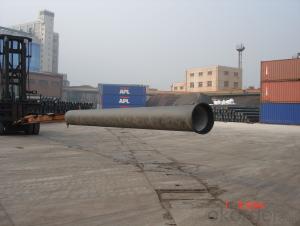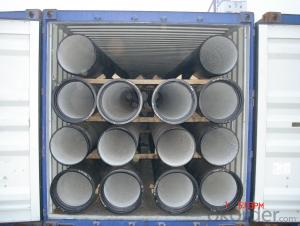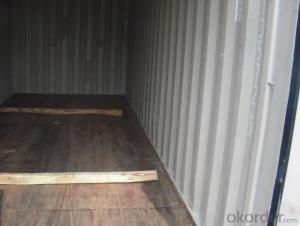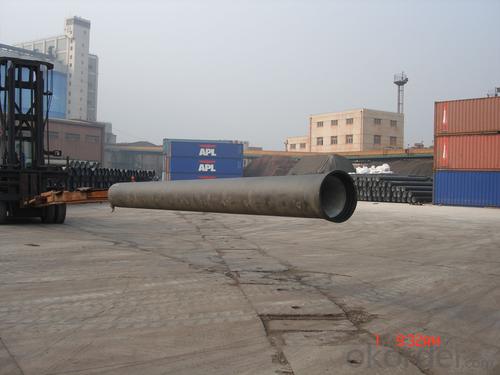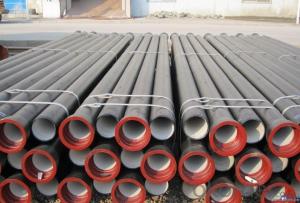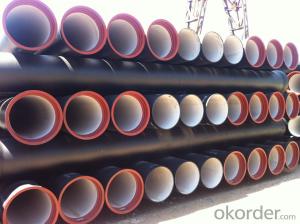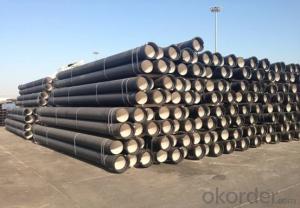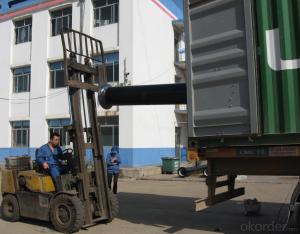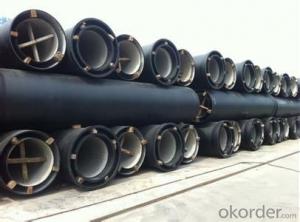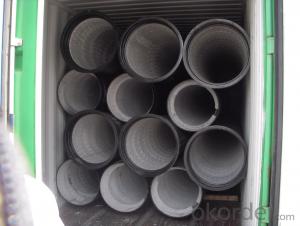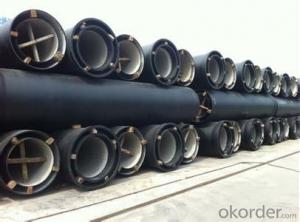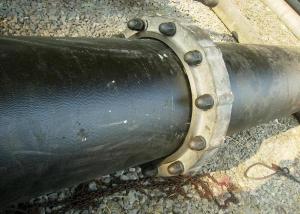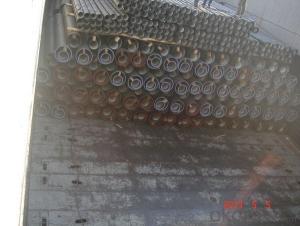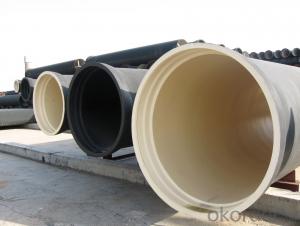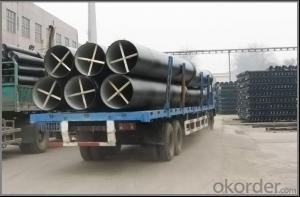DUCTILE IRON PIPES C Class DN1400
- Loading Port:
- China Main Port
- Payment Terms:
- TT OR LC
- Min Order Qty:
- -
- Supply Capability:
- -
OKorder Service Pledge
OKorder Financial Service
You Might Also Like
Ductile Iron Cast Pipe is without any defects compare with tradition casting tech, which has many advantages particularly as follow:
(1) High density. In the "vertical upward casting" process, the melt iron of centre liquid column in center crystallizer is continuously feeding for volume shrinkage caused by condensation tube at outer circumference , which lead to be free of shrinkage porosity.
(2) High purity. When melt iron pouring, the mixed impurities such as gas, dross, sand grain which are lighter than melt iron could be eliminated at furnace mouth, its impossible to enter into the crystallizer through the channel, so the melt iron into the crystallizer is very pure.
(3) Strength with toughness. The cooling speed provided by continuous crystallizer is 30 times than sand casting and 5 times than centrifugal casting, and doesn't produce white iron, the eutectic cell volume of continuous cast iron is one eighth to one tenth compare with traditional cast iron. The density of graphite nodule in ductile iron can reach 300-700 pcs/mm2. Therefore, all reason above improve the strength and toughness of continuous cast iron.
(4) Free machining. The high speed cooling make the hardening phase (such as boride, steadite) not appear like reticular, massive or thick, but diffuse like fish bone and pane in shape, moreover, there are tiny graphite flakes inlaid hardening phase. It's free machining in BrinellHardness the range of 250-300HB. However, the Brinell Hardness of 250 is top limit to common metal materials.
(5) Uniform composition of tube wall. The convection mixing of liquid column caused by marching type drawing in crystallizer make the composition of tube wall well-distributed, and concentration gradient very little.
(6) High productivity. To the wall thickness of tube under 10mm, the speed of continuous casting is 1 meter/min, to the wall thickness of tube under 20mm, the speed of continuous casting is 0.5 meter/min, which is high efficiency that centrifugal or other casting tech couldn't reach.
- Q: What is the expected fire resistance of ductile iron pipes?
- The fire resistance of ductile iron pipes can vary based on factors such as pipe wall thickness, installation quality, and surrounding conditions. However, in general, ductile iron pipes exhibit high fire resistance due to their durable and heat-resistant composition. Ductile iron is created by adding a small amount of magnesium to cast iron, which enhances its strength and flexibility. This results in ductile iron pipes being less prone to cracking or breaking under high temperatures compared to materials like PVC or HDPE pipes. Regarding fire resistance, ductile iron pipes can endure high temperatures for a prolonged period without significant structural damage. They have undergone testing and have been proven to maintain their integrity in fire situations for 2-4 hours, depending on the specific pipe design and installation. It is important to note that while ductile iron pipes possess high fire resistance, they are not fireproof. In the event of a fire, it is vital to adhere to proper fire safety procedures and seek advice from professionals to ensure the safety of the system and surrounding infrastructure.
- Q: What is the difference between spheroidal graphite cast iron QT400-15 and QT400-15A? What does the A mean later?
- The front is the material grade, and the back of the A should have special requirements.
- Q: Can ductile iron pipes be used in areas with high levels of hydrogen sulfide gas and corrosion potential?
- Ductile iron pipes can be used in areas with high levels of hydrogen sulfide gas and corrosion potential, but it is important to consider certain factors before making a decision. Ductile iron pipes have a high resistance to corrosion, especially when they are properly protected with external coatings and linings. This makes them suitable for environments with moderate levels of hydrogen sulfide gas and corrosion potential. However, in areas with extremely high levels of hydrogen sulfide gas and severe corrosion potential, other materials like corrosion-resistant alloys or specially coated pipes may be more appropriate. It is crucial to conduct a thorough evaluation of the specific conditions in the area to determine the suitability of ductile iron pipes. Factors such as the concentration of hydrogen sulfide gas, the presence of other corrosive elements or chemicals, and the overall corrosiveness of the environment should be considered. Additionally, the local regulations and industry standards must be consulted to ensure compliance and safety. In conclusion, while ductile iron pipes can withstand moderate levels of hydrogen sulfide gas and corrosion potential, a comprehensive assessment of the specific conditions is necessary to determine their suitability. Consulting with experts in the field and considering alternative materials may be required in areas with high levels of hydrogen sulfide gas and severe corrosion potential.
- Q: What is the expected buoyancy of ductile iron pipes?
- The expected buoyancy of ductile iron pipes can vary depending on several factors such as the diameter, wall thickness, and the specific gravity of the fluid being transported. However, in general, ductile iron pipes are known for their relatively low buoyancy compared to other materials like plastic or concrete. Due to their higher density and weight, ductile iron pipes tend to have a greater resistance to buoyancy forces. This makes them suitable for applications where buoyancy is a concern, such as water and wastewater transmission systems. The combination of their inherent strength and weight helps to keep the pipes grounded and prevents them from floating or rising to the surface. It is important to note that even though ductile iron pipes have lower buoyancy compared to other materials, they may still experience some level of buoyancy in certain scenarios, especially when the fluid being transported has a lower specific gravity. To mitigate this potential issue, additional measures such as anchoring or ballasting may be employed to ensure the stability and integrity of the pipeline system. Overall, while the expected buoyancy of ductile iron pipes is generally low, it is crucial to consider the specific conditions and requirements of the project to determine the most appropriate pipe material and design for optimal performance and safety.
- Q: What is the expected cyclic fatigue life of ductile iron pipes?
- Various factors such as material composition, pipe design, loading conditions, and environmental factors can affect the expected cyclic fatigue life of ductile iron pipes. However, ductile iron pipes are widely recognized for their exceptional ability to withstand fatigue. Ductile iron pipes are specifically engineered to endure cyclic loading, which is common in water distribution and sewer systems due to fluctuating pressures and vibrations. These pipes possess a unique microstructure that confers high strength and ductility, enabling them to resist crack formation and growth under cyclic loading. Numerous studies and industry standards have provided estimates for the expected cyclic fatigue life of ductile iron pipes. For instance, the American Water Works Association (AWWA) C151 standard recommends a design life of 100 years for ductile iron pipes used in water distribution systems, underscoring their long-term durability and resistance to fatigue. Furthermore, research studies have demonstrated that ductile iron pipes can withstand over 1 million cycles of loading without exhibiting any signs of fatigue failure. The fatigue strength of ductile iron pipes can be further augmented by employing protective coatings or linings to reduce the impact of corrosion and abrasion. Nevertheless, it is important to recognize that various factors, such as manufacturing quality, installation practices, and maintenance procedures, can influence the expected cyclic fatigue life of ductile iron pipes. Regular inspections, appropriate handling, and adherence to recommended installation guidelines can help ensure the longevity and performance of ductile iron pipes. In conclusion, while the expected cyclic fatigue life of ductile iron pipes can be subject to variation due to several factors, these pipes are generally renowned for their outstanding fatigue resistance and offer a dependable and enduring solution for water distribution and sewer systems.
- Q: Which is better, ductile iron pipe and spray plastic pipe?
- Spray pipe is: plastic composite pipe, steel pipe is a new composite material as matrix, through a special process in high temperature curing by walls melt spraying or adsorption of food grade epoxy powder coating or PE as raw material. It has excellent corrosion resistance and relatively small frictional resistance.
- Q: How do ductile iron pipes handle soil erosion?
- Ductile iron pipes are renowned for their exceptional strength and durability, rendering them highly resistant to the erosion of soil. The specific engineering of the material used in these pipes ensures their ability to withstand the detrimental effects of soil erosion, thereby guaranteeing long-lasting and dependable infrastructure. The composition of ductile iron pipes comprises a blend of iron, carbon, and other alloying elements, providing the necessary strength and resilience to withstand the forces exerted by soil erosion. These pipes possess a greater tensile strength than conventional cast iron pipes, enabling them to withstand pressure without deforming or cracking. Furthermore, ductile iron pipes boast a protective layer known as cement mortar lining, which acts as a barrier between the pipe and the surrounding soil. This lining offers an additional layer of resistance against corrosion and erosion caused by the chemical composition or abrasive particles present in the soil. Consequently, ductile iron pipes remain intact and continue to function effectively, even in areas experiencing high rates of soil erosion. In terms of installation, ductile iron pipes are specifically designed to be buried underground, ensuring their robust protection from direct contact with the soil. Additionally, their jointing systems are designed to provide secure and watertight connections, minimizing the risk of soil infiltration and subsequent erosion. Overall, ductile iron pipes have a proven track record of effectively combating soil erosion due to their superior strength, protective linings, and appropriate installation techniques. They offer a reliable and long-lasting solution for water and wastewater infrastructure, even in regions prone to soil erosion.
- Q: The difference between spheroidal graphite cast iron pipe and HDPE water supply pipe
- HDPE pipe is made of hot melt butt joint, and the strength of interface is very good. Ductile iron pipes are made of socket joint, and reinforced concrete piers shall be rammed on three links, elbows and other parts. In this regard, the cost of natural selection of ductile iron pipe, HDPE pipe than the choice of high.
- Q: Are there any special coatings or linings available for ductile iron pipe?
- Yes, there are special coatings and linings available for ductile iron pipe. These coatings and linings are applied to the internal and/or external surfaces of the pipe to provide protection against corrosion and extend the lifespan of the pipe. Some common coatings and linings used for ductile iron pipe include cement mortar lining, polyethylene encasement, epoxy coating, and polyurethane lining. These coatings and linings are designed to prevent the pipe from corroding when in contact with various substances such as water, chemicals, and soil. The specific coating or lining used depends on the application and the environment in which the pipe will be installed.
- Q: Is there a kind of pipe called lined ductile iron pipe? Seeking manufacturers?
- The 10kg pressure ball tube is also used as a drain, and the second is the W ductile iron pipe, i.e., without spigot, ductile tube, or lined ductile iron tube.
Send your message to us
DUCTILE IRON PIPES C Class DN1400
- Loading Port:
- China Main Port
- Payment Terms:
- TT OR LC
- Min Order Qty:
- -
- Supply Capability:
- -
OKorder Service Pledge
OKorder Financial Service
Similar products
Hot products
Hot Searches
Related keywords
